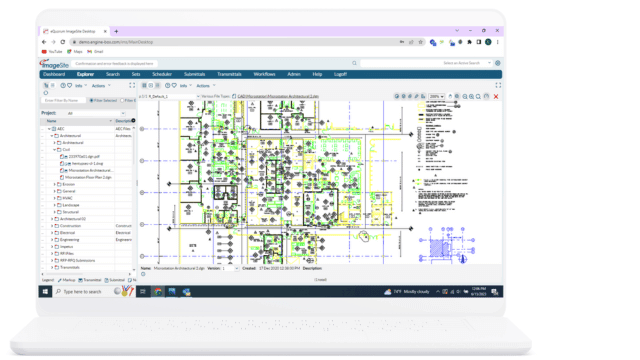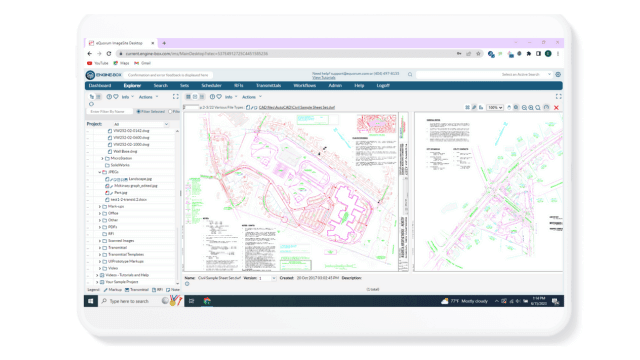How To Improve Project Management Through Workflow Automation
How To Improve Project Management Through Workflow Automation
Engineering workflow is traditionally defined as “the sequence of industrial, administrative, or other processes through which a piece of work passes from initiation to completion.” This is still true of modern workflows with the exception of a twist – automation. Before we begin discussing automation, lets first go over the three different types of workflows engineers may be accustomed to working with.
Map-Centric Workflows
Map-centric workflows assign employees activities that are passed on to other employees to complete. In this type of workflow, projects can be passed between employees with varying job functions pertinent to the completion of the project.
For example, let’s say a company wants to create a new product. The first step in the engineering design process is to identify the needs and constraints of the project. During this step, information must be passed between team members, managers, and quite possibly other members of the organization.
Once the project objectives have been outlined, it is passed on to the drafters and designers, who are tasked with creating technical drawings that communicate how the product is constructed and its primary functions. This step often requires approvals from other members of the engineering department before advancing to the latter stages of the workflow. This workflow can get complicated, however, since engineers often must design and redesign multiple versions of a draft before moving forward.
Task-Centric Workflows
Task-centric workflows typically allow multiple employees to work on tasks simultaneously and can help provide employees with an in-depth understanding of the workflows’ processes. Contrarily, linear task-centric workflows are simpler to manage but have drawbacks such as bottlenecks. Enabling employees to work on tasks concurrently, eliminates wait times caused by congestion in earlier stages of a workflow.
While task-centric workflows are efficient by nature, there are many scenarios in which they cannot be used. These scenarios facilitate the requirement for a more complex workflow configuration, bringing us to Document-Centric Workflows.

Engineering Workflow
Automatically manage and distribute files and documents for review, approval, and processing. Adjust user permissions at each step, ensuring your company’s files are managed securely.

Document Version Control
Track document changes, capture key decisions and document the reviewing process. Stay in-control of essential workflows while ensuring correct versions of files are being used.
Document-Centric Workflows
Document-centric workflows are somewhat linear in the sense that a step must be completed before being passed on to the latter stages of a workflow, however, these are typically integrated workflows, possessing both the traits of map-centric and task-centric workflows. CAD drawings and other design files are passed between several engineers before progressing in the workflow and can be sent back to earlier stages numerous times before final approval.
In most cases, employees with different levels of authorization will need to access the same documents in different stages of a workflow. Managing the transfer of files between locations while ensuring proper versioning and user permissions is often difficult and can be confusing for those without a system to automate these processes.
Workflow Automation
Workflow automation is used to improve everyday business and engineering processes by allowing engineers to define their work as a series of interrelated workflow steps with assigned deadlines and associated notifications. Workflow and document management software can be used to create conditional statements that automatically move files and documents to their respective locations while automating document version control, metadata changes, watermarking, and security modifications to guarantee users are accessing the correct and allowable version of a document at any given time. Workflow management can also be used to automate user permissions as a document or file is passed between members of an organization, whether it be for redlining, document approval, or other workflow-related tasks.
While there is other workflow and document management software, none are quite as robust as ImageSite, eQuorum’s on-premise workflow and document management solution. Through automation, system administrators can eliminate the burden of managing complex workflows from engineers and designers, giving them more time to focus on the projects at hand. This, in turn, can increase workflow efficiency and significantly reduce project completion time.
Takeaway
Rome wasn’t built in a day but had the Romans used a modern workflow management system, it certainly would have been built much quicker. As organizations migrate towards newer, more advanced systems, we begin to feel optimistic about the future of engineering and design.
In this day and age, consumers are eager to see rapid technological advancements made possible through innovation and efficient processes, and without the proper systems in place, your company won’t be the one to give it to them. With that being said, you are likely reading this because you’re an innovator, someone who is fueled by new ideas and who is ready to move towards the new “now” of project management.
Read the White Paper: Managing Technical Workflows in Real-Time
Additional EDMS Features
Our EDMS solutions
ImageSite and EngineBox are eQuorum’s robust workflow and document management solutions, created to help workers manage their essential workflows while maintaining complete control over their engineering files and documents. Not only do they provide a secure collaboration site for workers, but they also help organizations manage document distribution with third parties like vendors, contractors, and customers. Both systems are offered at a competitive price, enabling organizations to get a quick return on their investment by providing the features and functionality needed to help organizations improve efficiency, productivity, and collaboration. Companies can choose from concurrent user subscriptions or named user subscriptions, ensuring organizations have subscription options that make sense for their business.

ImageSite®
Our single source engineering workflow and document management system. Built in HTML5 so there is no software to deploy to client computers or mobile apps to download. Offered as an On-premise or Private Cloud system.
EngineBox™
EngineBox is a cloud based workflow and document management version of ImageSite that resides outside the corporate network.
Our EDMS solutions
ImageSite and EngineBox are eQuorum’s robust workflow and document management solutions, created to help workers manage their essential workflows while maintaining complete control over their engineering files and documents. Not only do they provide a secure collaboration site for workers, but they also help organizations manage document distribution with third parties like vendors, contractors, and customers. Both systems are offered at a competitive price, enabling organizations to get a quick return on their investment by providing the features and functionality needed to help organizations improve efficiency, productivity, and collaboration. Companies can choose from concurrent user subscriptions or named user subscriptions, ensuring organizations have subscription options that make sense for their business.

EngineBox™
EngineBox is a cloud based workflow and document management version of ImageSite that resides outside the corporate network.
The eQuorum Customer Promise
In 2005, eQuorum developed the first all browser-based EDMS. The system, although for on-premise use, was still created to remove client software and JAVA from user computers and allow users to have a single viewer based on the simple navigation functionality of browsers. Today, eQuorum provides that same application in a private Cloud or a SaaS Cloud option. We can do this because we are, and have always been, browser-based, understanding the enhanced speed, security, and usability of this technology.
With the abundance of document management systems on the market today, there’s no doubt that choosing the right Cloud document management software can be a difficult decision. eQuorum is here to provide a comprehensive, powerful, and most importantly – affordable Cloud document management solution. We believe in providing real value to our customers by eliminating unnecessary costs, providing industry-leading functionality, and equipping your team with the right tools using cutting edge technology to bring your products to market faster.
eQuorum®
We specialize in engineering workflow and document management. Our comprehensive, yet easy-to-use software provides the solution to manage data from design to manufacturing and production, to sales, support and administration.